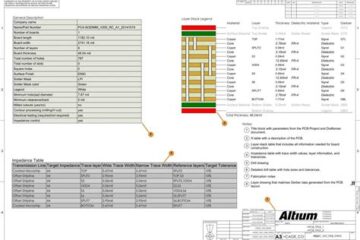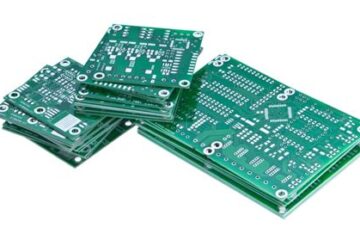What are Annular rings?
Annular rings, also known as PCB Annular Rings, are the copper-plated holes in a printed circuit board (PCB) that provide electrical connectivity between layers of the board. These rings are essential components in PCB design and manufacturing, as they ensure reliable connections and signal integrity throughout the board.
Structure of Annular Rings
An annular ring consists of two main parts:
- The hole (or via) drilled through the PCB
- The copper pad surrounding the hole
The hole allows components to be soldered onto the board or for different layers to be connected electrically. The copper pad around the hole provides a surface for soldering and ensures a strong mechanical and electrical connection.
Types of Annular Rings
There are two main types of annular rings:
-
Non-plated through-hole (NPTH) annular rings: These rings are not plated with copper and are used for mechanical purposes, such as mounting the PCB or providing support for components.
-
Plated through-hole (PTH) annular rings: These rings are plated with copper and provide electrical connectivity between layers of the PCB. They are used for soldering components or creating vias between layers.
Importance of Annular Rings in PCB Design
Annular rings play a crucial role in PCB design and manufacturing. They impact several aspects of the board’s performance and reliability.
Electrical Connectivity
The primary function of annular rings is to provide electrical connectivity between layers of the PCB. By creating a conductive path through the board, annular rings allow signals to pass from one layer to another, enabling complex circuits to be built on a single board.
Signal Integrity
Annular rings are essential for maintaining signal integrity in a PCB. Poorly designed or manufactured annular rings can lead to signal reflections, crosstalk, and other issues that can degrade the performance of the circuit. By ensuring that annular rings are properly sized and spaced, designers can minimize these problems and maintain the integrity of the signals passing through the board.
Mechanical Strength
In addition to their electrical functions, annular rings also provide mechanical strength to the PCB. The copper pads surrounding the holes help to reinforce the board and prevent the holes from becoming damaged or deformed during the manufacturing process or in use.
Solderability
Annular rings also play a critical role in the solderability of components on the PCB. The copper pads provide a surface for the solder to adhere to, ensuring a strong and reliable connection between the component and the board. Proper sizing and spacing of annular rings are essential for achieving good solderability and preventing issues such as bridging or insufficient solder joint strength.
Annular Ring Design Considerations
When designing annular rings for a PCB, several factors must be considered to ensure optimal performance and reliability.
Annular Ring Size
The size of the annular ring is one of the most important design considerations. The ring must be large enough to provide adequate electrical and mechanical connection, but not so large that it interferes with other components or traces on the board.
The minimum annular ring size is typically determined by the manufacturing capabilities of the PCB fabricator and the requirements of the design. In general, smaller annular rings are more challenging to manufacture and may require more advanced equipment and processes.
| Aspect Ratio | Minimum Annular Ring (mm) |
|---|---|
| 1:1 | 0.05 |
| 2:1 | 0.075 |
| 3:1 | 0.1 |
Annular Ring Spacing
In addition to size, the spacing between annular rings is also critical. Annular rings must be spaced far enough apart to prevent short circuits and signal interference, but close enough to maximize board density and minimize the overall size of the PCB.
The minimum spacing between annular rings is typically determined by the voltage and current requirements of the circuit, as well as the manufacturing capabilities of the PCB fabricator.
| Voltage (V) | Minimum Spacing (mm) |
|---|---|
| <100 | 0.2 |
| 100-500 | 0.5 |
| >500 | 1.0 |
Drill Hole Size
The size of the drill hole is another important consideration in annular ring design. The hole must be large enough to accommodate the component lead or via, but not so large that it weakens the mechanical strength of the board or reduces the size of the annular ring.
The minimum drill hole size is typically determined by the size of the component lead or via, as well as the manufacturing capabilities of the PCB fabricator.
| Component Lead Diameter (mm) | Minimum Drill Hole Size (mm) |
|---|---|
| 0.5 | 0.7 |
| 0.8 | 1.0 |
| 1.0 | 1.2 |
Material Selection
The choice of material for the PCB and the annular rings can also impact their performance and reliability. The most common materials used for PCBs are FR-4, a glass-reinforced epoxy laminate, and high-frequency laminates such as Rogers or Isola.
The choice of material will depend on the requirements of the circuit, such as the operating frequency, Dielectric Constant, and loss tangent. In general, high-frequency laminates offer better performance at higher frequencies but are more expensive than FR-4.

Manufacturing Considerations
In addition to design considerations, there are also several manufacturing considerations that must be taken into account when working with annular rings.
Plating
The plating process is critical for creating high-quality annular rings. The copper plating must be thick enough to provide adequate conductivity and mechanical strength, but not so thick that it interferes with the solderability of the board.
The most common plating materials used for annular rings are copper, gold, and silver. Copper is the most commonly used material due to its low cost and good conductivity. Gold and silver are used in high-reliability applications where corrosion resistance and solderability are critical.
Drilling
The drilling process is another critical step in the manufacturing of annular rings. The holes must be drilled accurately and consistently to ensure that the annular rings are properly sized and spaced.
There are several types of drilling processes used in PCB manufacturing, including mechanical drilling, laser drilling, and plasma drilling. The choice of drilling process will depend on the size and complexity of the board, as well as the manufacturing capabilities of the PCB fabricator.
Inspection
Finally, inspection is a critical step in the manufacturing of annular rings. The rings must be inspected for defects such as voids, cracks, or insufficient plating thickness.
There are several inspection methods used in PCB manufacturing, including visual inspection, automated optical inspection (AOI), and X-ray inspection. AOI and X-ray inspection are particularly useful for detecting internal defects that may not be visible on the surface of the board.
Common Annular Ring Defects
Despite the best efforts of designers and manufacturers, defects can still occur in annular rings. Some of the most common defects include:
Insufficient Annular Ring
An insufficient annular ring occurs when the copper pad surrounding the hole is too small to provide adequate electrical or mechanical connection. This can lead to poor solderability, weak mechanical strength, and signal integrity issues.
Drill Breakout
Drill breakout occurs when the drill hole is not centered within the annular ring, causing the hole to break out of the copper pad. This can lead to poor electrical connection and mechanical strength, as well as signal integrity issues.
Plating Voids
Plating voids are small gaps or holes in the copper plating of the annular ring. These voids can occur during the plating process and can lead to poor electrical conductivity and mechanical strength.
Annular Ring Cracks
Annular ring cracks are small fractures in the copper pad surrounding the hole. These cracks can occur during the manufacturing process or in use and can lead to poor electrical conductivity and mechanical strength.
Troubleshooting Annular Ring Issues
If issues with annular rings are detected during the manufacturing process or in use, there are several steps that can be taken to troubleshoot and resolve the problem.
Visual Inspection
The first step in troubleshooting annular ring issues is to perform a visual inspection of the board. This can help to identify obvious defects such as drill breakout or insufficient annular ring.
Electrical Testing
If visual inspection does not reveal any obvious defects, electrical testing can be performed to identify issues with conductivity or signal integrity. This may involve using a multimeter or oscilloscope to measure resistance or signal quality.
Cross-Sectional Analysis
If electrical testing does not reveal the root cause of the issue, cross-sectional analysis may be necessary. This involves cutting the board along the affected area and examining the cross-section under a microscope to identify any internal defects or anomalies.
Rework and Repair
Once the root cause of the annular ring issue has been identified, rework and repair may be necessary to correct the problem. This may involve adding additional copper plating, filling in voids or cracks, or redrilling the affected holes.
Frequently Asked Questions
What is the difference between a via and an annular ring?
A via is a plated through-hole that connects two or more layers of a PCB. An annular ring is the copper pad surrounding the via that provides electrical and mechanical connection.
What is the minimum size of an annular ring?
The minimum size of an annular ring depends on the manufacturing capabilities of the PCB fabricator and the requirements of the design. In general, the minimum annular ring size is around 0.05mm for a 1:1 aspect ratio.
What materials are used for annular ring plating?
The most common materials used for annular ring plating are copper, gold, and silver. Copper is the most commonly used material due to its low cost and good conductivity. Gold and silver are used in high-reliability applications where corrosion resistance and solderability are critical.
What are the most common defects in annular rings?
The most common defects in annular rings include insufficient annular ring, drill breakout, plating voids, and annular ring cracks. These defects can occur during the manufacturing process or in use and can lead to poor electrical conductivity, mechanical strength, and signal integrity.
How can annular ring issues be troubleshot?
Annular ring issues can be troubleshot through a combination of visual inspection, electrical testing, cross-sectional analysis, and rework/repair. The specific approach will depend on the nature and severity of the issue, as well as the manufacturing capabilities of the PCB fabricator.
Conclusion
Annular rings are a critical component of PCB design and manufacturing. They provide electrical and mechanical connection between layers of the board and ensure signal integrity and reliability.
Designing and manufacturing high-quality annular rings requires careful consideration of factors such as size, spacing, drill hole size, and material selection. Proper inspection and troubleshooting are also essential for identifying and resolving any issues that may arise during the manufacturing process or in use.
By understanding the importance of annular rings and following best practices for design and manufacturing, PCB designers and manufacturers can ensure the highest levels of performance and reliability in their products.



0 Comments